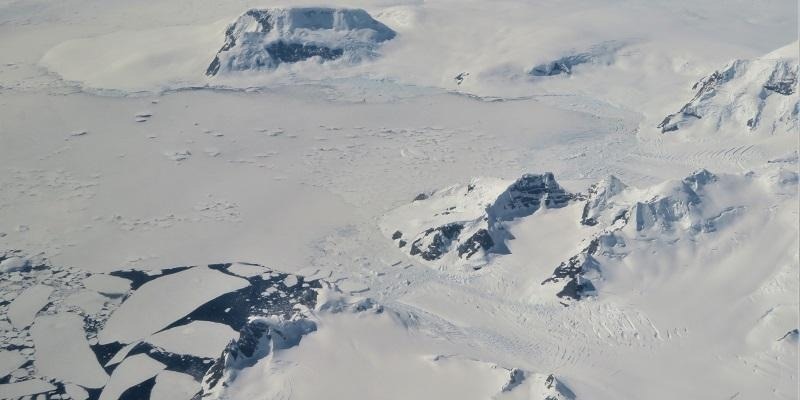According to researchers, glaciers along the Antarctic peninsula are flowing faster in the summer due to a combination of melting snow and warmer ocean waters.
 Aerial photograph of a glacier on the Antarctic Peninsula. Image Credit: Dr. Anna Hogg, University of Leeds
Aerial photograph of a glacier on the Antarctic Peninsula. Image Credit: Dr. Anna Hogg, University of Leeds
The glaciers, which are massive blocks of moving ice, travel at a rate of about 1 km per year on average. However, a new study has discovered a seasonal variation in the ice flow speed, which increases by up to 22% in the summer when temperatures are higher.
The study sheds light on how climate change might well impact glacier behavior and the role glaciers perform in sea-level rise.
Researchers’ ability to get onto the glaciers to carry out fieldwork has previously limited their research of the rugged Antarctic peninsula. However, breakthroughs in satellite technology are disclosing new insights into the rate at which glaciers move and drain water into the surrounding ocean from space.
Antarctic Peninsula—And Global Sea Levels
The Antarctic Ice Sheet is the world’s largest frozen water reservoir. It is anticipated that glacier meltwater accelerated global sea levels by 7.6 mm between 1992 and 2017. One of the major unknowns in climate change modeling is how this will change in the future.
A group led by researchers from the University of Leeds used over 10,000 satellite images captured above the Antarctic Peninsula between 2014 and 2021 to comprehend how glacier flow into the waters surrounding the Antarctic changes during colder and warmer periods.
One of the important findings of this study is that it reveals how sensitive glaciers in Antarctica are to the environment. We have known for a long time that glaciers in Greenland have a seasonal behavior, but it is only now that satellite data has shown similar behavior in Antarctica.
Ben Wallis, Study First Author and Doctoral Researcher, School of Earth and Environment, University of Leeds
The study was published in the journal Nature Geoscience.
Antarctic Peninsula
The Antarctic Peninsula is Antarctica’s most northern and warmest region. It has a 1,000-kilometer-long mountainous spine, equivalent to the length of the east coast of Great Britain, and is home to a diverse marine ecosystem that includes seals, penguins, and whales.
The glaciers on the peninsula’s west coast drain ice from the ice sheet directly into the Southern Ocean.
The glacier accelerates in the summer as the snow melts and the temperature of the Southern Ocean rises, according to satellite data analysis. Water from melting snow is thought to act as a lubricant between the ice sheet and the underlying rock. As a result, friction decreases and the glaciers slide faster.
Furthermore, the warmer waters of the Southern Ocean corrode the moving ice’s front, reducing the buttressing forces it imposes to resist ice flow.
The Antarctic Peninsula has seen some of the most rapid warming of any region on Earth. Continuing work like this will help glaciologists monitor how quickly change is occurring, enabling accurate assessments of how Earth’s ice will respond to climate change.
Dr Anna Hogg, Study Author and Associate Professor, Institute for Climate and Atmospheric Science, University of Leeds
The investigators have also written a briefing about their study for Nature.
Earth Observation from Space
Data from the European Space Agency and European Commission Copernicus Sentinel-1 satellite was used for the research. It offers weekly monitoring around the entire coastline of Antarctica.
The satellite is equipped with synthetic aperture radar, which can “see” through clouds, allowing glacier measurements to be captured both day and night.
This study highlights how high-resolution satellite images can help us monitor how the environment is changing in remote regions. Future satellites, such as the family of Copernicus Sentinel expansion missions, promise to bring enhanced continuity and capabilities that will spearhead further insight into the characteristics and processes governing ice mass balance and sea-level rise.
Craig Donlon, European Space Agency
Journal Reference:
Wallis, B. J., et al. (2023) Widespread seasonal speed-up of west Antarctic Peninsula glaciers from 2014 to 2021. Nature Geoscience. doi.org/10.1038/s41561-023-01131-4.